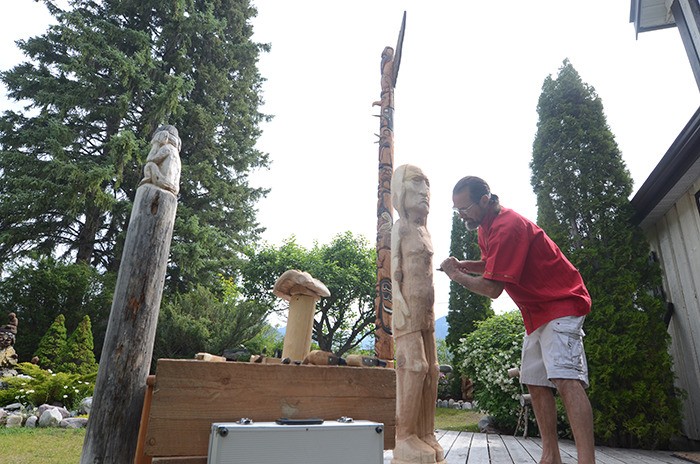“The soul comes through the eyes.” That was the first thing Jack Olson said to me as I walked into his luminous studio and was greeted by a myriad of bright and colourful faces.
The emotion was strikingly transparent on the faces of his creations: totem poles, paintings and sculptures, alive with a diverse array of expressions that define the human experience. There is no mistaking that Jack is in touch with the inner life of his muses.
“The eyes — that’s what stands out in most of my paintings,” said Jack of his emotive characters.
“I like primitive art because it’s simple, but has so much power to it,” the calm, meditative and soft- spoken artist proudly stated of the inspiration behind his work.
What strikes a deep impression as well are the gardens that Yvonne Olson, Jack’s wife of 37 years, created to showcase Jack’s work.
Upon entering the serenity and beauty of the gardens at the J. Olson Studio in Windermere, the sensation that one is leaving a separate reality and entering an entirely new universe, constructed over a journey spanning 32 years, is unmistakable.
“We welcome everyone — we want people to see my art. I like to have atmosphere, that’s how I like to live — with peacefulness,” said Jack of the tranquil space.
The impressive garden serves as an oasis, housing mind-blowing carvings, 35-foot totem poles, the Three Watchmen carvings that protect and guard, and a myriad of unreal, mystical, and intriguing faces staring back at all who are lucky enough to observe.
“My poles are often story poles — I read up on the myths of the west coast, and then carve them,” Jack said. “If you understand the myth, you can read my poles and the legends and myths won’t be forgotten, they will be in the poles.”
After finishing a four-year degree at the Alberta College of Art and Design, Jack worked in the graphic arts for awhile, married his wife Yvonne, and fathered two equally artistic children, Ryan and Kimberly.
“We decided we wanted to raise our children here, packed up and moved in the eighties to start a new life. It became about quality, not quantity,” Mr. Olson said of his quest to create something genuine. Going into fine art eventually led Jack to fall back into carpentry, where he combined his visual gifts with carpentry and started to experiment with mixed mediums including chainsaw carving.
“I ended up taking a mask carving workshop with a master carver in Calgary.” This led the then-chainsaw artist to try his hand at poles. He never looked back.
“My first one took the longest; it was a summer project, let’s say that.”
Much of the artist’s work is defined by his extensive travels. Having travelled through Cuba, the Cook Islands, South East Asia, China and all over Mexico, the distinguished totem pole carver, painter, and sculptor acknowledged that Mexico was particularly influential.
“I got to know some Mexican artists down there. They were a huge influence — they painted large, using bright colours,” commented Jack on the technique so apparent in his craft. “I love bright colour, I use pure colour when I paint and mix them on the canvas.”
There is a strong native influence in the artist’s work, possibly due to his grandmother who was French-Metis. It seems Jack has dedicated his mixed-medium process and “follow life as it comes” philosophy to native, indigenous, and tribal people’s who have altered his experiences and perceptions, as much as he has altered theirs.
“I ended up teaching children in a Mexican fishing village to paint faces on tiny rocks. Eventually, they ended up giving them back to us as gifts,” said Jack of the talented and precocious children he met on his travels.
“My paintings are kind of emotional. There has to be something in the portrait, otherwise I find that it’s not successful. Sometimes it will take me awhile to get a project going — when I get the idea I will do some research on it, then I know what I’m going to do and can see what the end result will be.”
“History and culture — it influences my work, my paintings. I love the different cultures, traditions, and costumes.”
